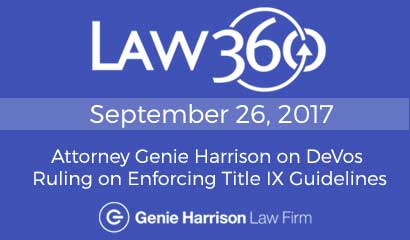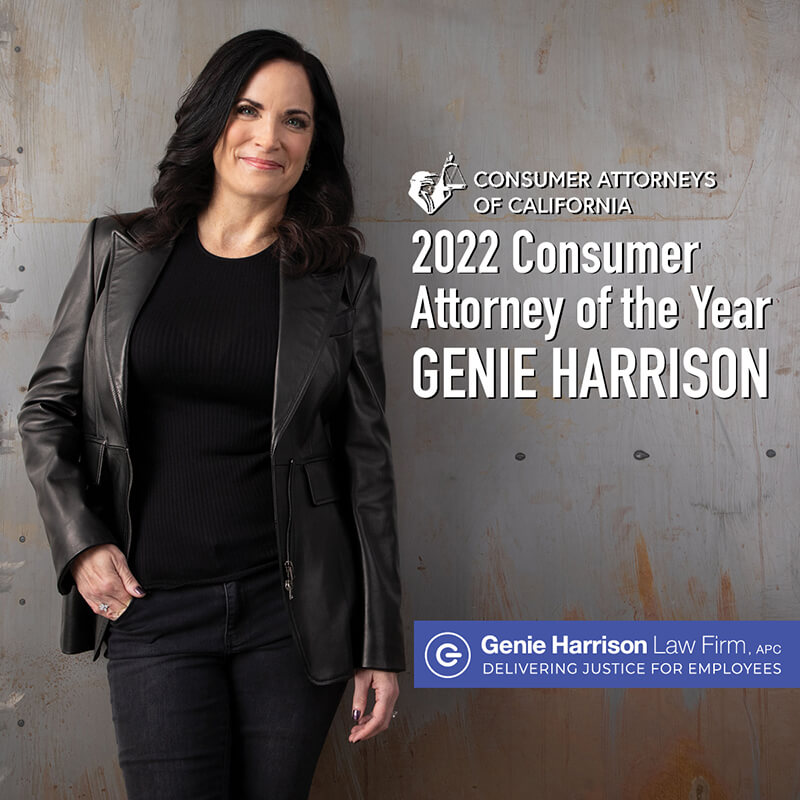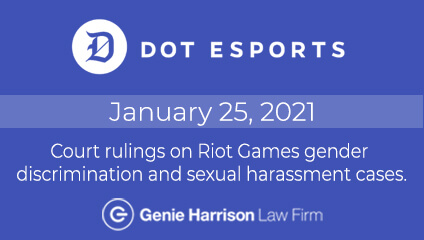The Truth About Rolling Back Obama-Era Title IX Guidelines
September 26, 2017 – By Genie Harrison for Law 360.com.
CLICK HERE to download the pdf or read the story below:
“I have an arrangement with a student each semester, because I don’t get taken care of at home. You take care of my needs and I will take care of yours. You will make yourself available to have sex with me once a week as and when I request it, and I will make sure that you get an A in class. You won’t have to go to class, and I’ll buy you a car.”
These are statements made by professors to students I have recently represented against colleges and universities. And yes, there’s proof in these cases — in the professors’ own texts, in their “Sugar Daddy” profiles, and other online communications, most of which are readily accessible to anyone who searches, including their employers.
Lest there be any misunderstanding about how often sexual harassment and assault happens to students, I offer the following:
- One in five women and one in 16 men are sexually assaulted while in college.[1]
- More than 90 percent of sexual assault victims on college campuses do not report the assault.” Id.
- 3 percent of men at one university who self-reported acts qualifying as rape or attempted rape admitted to committing repeated rapes. Id.
- According to the Chronicle of Higher Education, over the past six years the government has conducted 432 investigations of colleges for possibly mishandling reports of sexual violence. [2]
- So far, 73 cases have been resolved and 359 remain open. Id.
- There are active Office of Civil Rights investigations involving at least 20 colleges and universities in California, with multiple cases at some. Id.
- The Chronicle of Higher Education’s Title IX Investigation Tracker includes the ability to filter by state and by whether the investigation is active or resolved, among other filters, showing the prevalence and seriousness of sexual abuse accusations across the country.
Anecdotally, based on personal conversations with my peers and students I represent, sexual harassment and assault in schools occur much more frequently than “only” one out of five females. In my personal circle and professional experience, the number is more like three out of five.
And if suffering the daily harms and losses from educational sexual harassment and sex abuse isn’t enough, Title IX law sets a high bar for victims in bringing litigation to recover damages.
When a teacher sexually harasses a student, “damages may not be recovered … unless an official of the school district who at a minimum has authority to institute corrective measures on the [school’s] behalf has actual notice of, and is deliberately indifferent to, the teacher’s misconduct.”
Gebser v. Lago Vista Independent School District, 524 U.S. 274, 277 (1998). Actual knowledge and deliberate indifference can be challenging to prove.
If this is the standard for damages claims, what are the standards of Title IX enforcement within the schools themselves?
Many have heard about the Obama administration’s U.S. Department of Education “Dear Colleague” letter. In response to alarming rates of campus sexual violence, President Barack Obama’s Department of Education in 2011 shared guidelines for handling sexual harassment and sexual assault incident reports in schools. The guidelines indicated how the Department of Education would review and enforce Title IX complaints.
The guidelines are predicated on an acknowledgement that sexual harassment and violence at school create a hostile educational environment that can interfere with the student’s ability to learn or participate in educational activities. The most controversial guidelines include that the standard of proof in sexual assault cases should be a preponderance of evidence standard, a 60-day limit on adjudications regarding alleged violations and allowing accusers to appeal not-guilty findings.
Additional 2011 Obama administration guidelines for enforcing Title IX on campus include:
- If a school knows or reasonably should know about student-on-student harassment that creates a hostile environment, Title IX requires the school to take immediate action to eliminate the harassment, prevent its recurrence, and address its effects;
- Schools also are required to publish a notice of nondiscrimination, and to adopt and publish grievance procedures;
- Schools need to ensure that their employees are trained to report harassment to appropriate school officials, and so that employees with the authority to address harassment know how to respond properly;
- The school’s inquiry must in all cases be prompt, thorough and impartial;
- In cases involving potential criminal conduct, school personnel must determine, consistent with state and local law, whether appropriate law enforcement or other authorities should be notified;
- The school may weigh a request for confidentiality against the following factors: the seriousness of the alleged harassment; the complainant’s age; whether there have been other harassment complaints about the same individual; and the alleged harasser’s rights to receive information about the allegations if the information is maintained by the school as an “education record” under the Family Educational Rights and Privacy Act (FERPA), 20 U.S.C. § 1232g; 34 C.F.R. Part 99;
- Schools are strongly discouraged from allowing the parties personally to question or cross-examine each other during the hearing. Allowing an alleged perpetrator to question an alleged victim directly may be traumatic or intimidating, thereby possibly escalating or perpetuating a hostile environment;
- Remedies for the complainant might include, but are not limited to: providing an escort to ensure that the complainant can move safely between classes and activities; ensuring that the complainant and alleged perpetrator do not attend the same classes; and moving the complainant or alleged perpetrator to a different residence hall;
- Schools should provide an appeals process, accessible to both parties; and,
- Any real or perceived conflicts of interest between the fact-finder or decision-maker and the parties should be disclosed.
These are the inschool policies and practices to which the Trump administration and Education Secretary Betsy DeVos object — they say the system has failed for the victims and accused. On Friday Sept. 22, they rolled back the schools’ obligations to act quickly, investigate aggressively and take these cases seriously, despite the fact that horrific professorial sexual harassment is still occurring 45 years after Title IX was enacted and six years after the Dear Colleague letter established more aggressive processes. But here’s the truth: Rolling back protections and standards only helps the accused, not the victims, who already struggle with stigmatization, efforts to dissuade them from reporting and intense daily trauma.
Whether one agrees with all of the Obama administration’s Title IX guidelines or not, the fact is that the Trump administration’s intended repeal is a blow to young women attending these institutions.
For one, DeVos’ repeal of the Obama administration’s Title IX guidelines will be a dog whistle to perpetrators, in the same way as President Donald Trump’s post-Charlottesville statements were dog whistles to white supremacists.
Attorneys working on these types of cases can expect to see fewer incidents reported, fewer reported incidents investigated, fewer findings against the accused and worse repercussions for the victims because they did not obtain a sliver of justice through the internal reporting process. It may well be that the state of affairs returns to pre-Obama administration guidelines, which means that more justice will have to be obtained in court, because less is offered in school.
Colleges may eventually wonder whether DeVos did anybody, other than the predators, any favors by rolling back the Obama administration’s guidance.
Genie Harrison is lead trial attorney at the Genie Harrison Law Firm in Los Angeles.
The opinions expressed are those of the author(s) and do not necessarily reflect the views of the firm, its clients, or Portfolio Media Inc., or any of its or their respective affiliates. This article is for general information purposes and is not intended to be and should not be taken as legal advice.
[1] National Sexual Violence Resource Center, Statistics About Sexual Violence, 2015.
[2] Chronicle of Higher Education, Title IX Investigation Tracker, https://projects.chronicle.com/titleix/investigations/.







